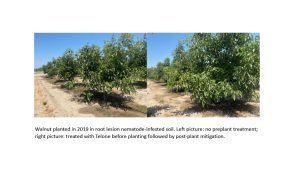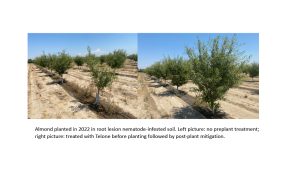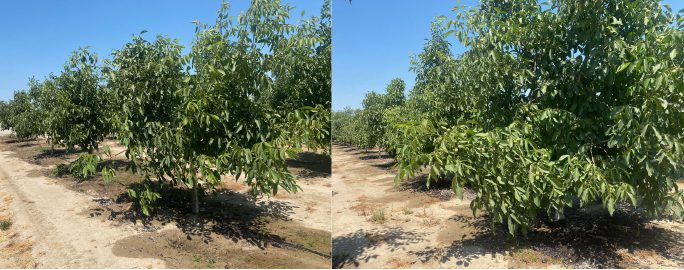With restrictions on the horizon in California for the soil fumigant Telone II, or 1,3-D, researchers are racing to develop cost effective alternatives for nematode control in walnut and almond production.
Andreas Westphal, UC Riverside nematologist, said he has 10 or so trials out at the moment looking into nematode control. And that’s not counting the rootstock trials.
Among his trials, Westphal is looking at preplant alternatives to Telone II, post-plant nematicides, and trying to pin down an economic threshold in almonds for the root lesion nematode.
Almonds, which appear to be less sensitive to lesion nematode than walnuts, are still sensitive to the pest, Westphal said, but to date, no economic threshold is available in almonds. In walnuts, the economic threshold is one nematode per 250 cubic centimeters of soil.
Other nematodes of concern in the two tree nuts include the ring nematode and root-knot nematode, which causes problems on Paradox and English walnut rootstocks, according to UC Integrated Pest Management (IPM) Guidelines.
“In many areas of the state and with current rootstocks, ring nematodes and root-knot nematodes are not the largest problem in walnuts,” Westphal said. “In almonds, rootstocks with resistance to root-knot nematodes are available and very effective against southern root-knot nematodes.
“There are no rootstocks available with resistance to the ring nematode in almonds,” he added, “but Lovell does have some tolerance to it. However, Lovell is very susceptible to root-knot nematodes.”
The severity of the damage nematodes inflict on almond and walnut trees depends on the age of the tree and density of the nematode population, with young trees particularly sensitive, according to UC IPM Guidelines. Mature trees can tolerate some nematodes, but can still show a lack of vigor, poor growth and reduced yield under high nematode pressure.
Start Clean
One of the points Westphal said he has stressed for years in walnut and almond grower presentations is the importance of starting with a clean field when planting an orchard.
“When you plant a new tree, whether it be potted or bare root, it will go through transplant shock upon being put in the soil, and the smaller the root system, the more damage the tree will incur if nematodes are present. And it is very difficult to recover from that,” Westphal said. “When that happens, you are constantly behind the 8 Ball because you are trying to play catch-up.”
When sampling for nematodes, Westphal said it is important to do so at proper times of year. “You need to sample at a time when you can find the nematodes,” Westphal said. “Especially in fallow situations when the soil is bone dry, there is a high likelihood to miss them.”

Optimally, Westphal recommends growers sample for nematodes before removing orchards. “Take your soil sample at that time, because then you can go into the rootzone of the trees,” he said. “If you wait until the ground is fallow, you won’t know where the tree rows were anymore.”
Waiting until late in the summer, when soil conditions are dry and nematodes are typically deep in the soil profile will not provide accurate nematode counts, he said.
“There is always going to be enough moisture lower in the soil profile that will allow them to survive, and even if they decline in numbers, they have a very high reproductive potential,” he said. “So, as soon as the crop is there, they can very quickly build up their population numbers.”
He said it is important to identify which nematode species are present given that some nematode species are not known to be harmful to orchard health.
Soil Fumigation
For years, the solution to nematodes in California tree nuts was soil fumigation. Use of Telone II can help get orchards off to a good start and provide nematode protection well into the life of an orchard. Beginning January 1, however, use of Telone II could be more difficult with the proposed start of new Department of Pesticide Regulation restrictions.
As a recent article in West Coast Nut outlined, the restrictions would require increased soil moisture levels for Telone II applications, a restriction expected to decrease efficacy of an application and increase application costs. And the restrictions would require deeper injection of Telone for perennial crops, which could present challenges in terms of cost and equipment.
“That is foremost an issue for the applicator,” Westphal said, “because the company now either has to take a few shanks off of the applicator, meaning they get less done, or they need a bigger tractor to be able to pull that device through the soil. And of course, the provider will be looking to cover their expenses, so I assume that increase will be passed to the grower.”
Set-back restrictions, proposed to increase from 100 feet from a structure to 500 feet in some cases, also are expected to increase application costs, given the proposed restrictions can be mitigated by treating smaller parcels.
“That means the applicator has to be there more frequently with all his equipment, so that will also increase costs,” Westphal said.
The impending restrictions have increased the urgency to develop alternatives to Telone, Westphal said, and to provide an economic threshold for nematodes in almonds as soon as possible. “That is something we are working on, to find out when it is absolutely critical [to treat for nematodes.]”

Alternative Strategies
To date, researchers have uncovered some promising findings for alternative control strategies in trial plots at the Kearney Agricultural Research and Extension Center in Parlier, Westphal said. Among next steps, he hopes to bring some of the alternative strategies out to grower-cooperator fields.
“Once we know what treatments are the most promising, we intend to install trials at grower sites just to upscale application methods and to learn under commercial conditions,” Westphal said.
Among his trials, Westphal is studying whether a new method of anaerobic soil disinfestation, one that doesn’t require tarping and drip irrigation, can perhaps provide an efficacious and economically feasible alternative to Telone II.
“We are not quite there yet,” Westphal said. “But we are finding ways to apply it that is a lot less expensive than the traditional way it has been applied in the past where you need lots of plastic tarp and drip irrigation.”
Westphal is also looking into alternative application methods for the pre-plant product Dominus, a broad-spectrum soil fumigant with the active ingredient Allyl isothiocyanate.
“We have developed methods of applying it which make it economically competitive with the current Telone fumigation,” Westphal said. “So, we are pretty high on that.”
Dominus is not yet registered for use in California, and Westphal was hesitant to speculate when that might occur.
“I’m not privy to any information whether DPR would approve the application method that we have been using for it, which is a little bit different than it has been used before,” he said. “But this seems the only way to not need the plastic tarp and the drip irrigation set-up to apply it.”
Westphal is also looking into Salibro, or fluazaindolizine, a selective nematicide from Corteva Agriscience. It too is not yet registered for use in California tree nuts.
And he is researching efficacy of post-plant products, such as Movento, or spirotetramat, a nematicide/insecticide from Bayer Crop Science.
Overall, he said, nematode management remains a challenge that will require continued efforts on the part of both growers and researchers.
















